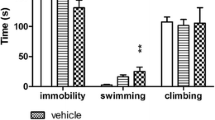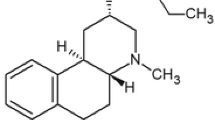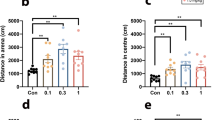Abstract
Administration of 1-(3-chlorophenyl)-biguanide (mCPB), a 5-HT3 receptor agonist (1 and 10 mg/kg IP), was found to be significantly anxiogenic in vehicle treated rats tested in the plus-maze, while having no significant effect in rats withdrawn for 24 h from 21 days diazepam treatment (2 mg/kg/day), suggesting a decreased agonist action at 5-HT3 receptors following withdrawal from chronic diazepam treatment. In the social interaction test, diazepam withdrawn rats showed a significant decrease in social interaction when compared to the chronic vehicle treated group. This anxiogenic response was reversed by low doses of zacopride (0.0001–0.01 mg/kg IP); in the vehicle treated animals 0.1 mg/kg was significantly anxiogenic. The overall pattern of results with zacopride is explained by suggesting that the anxiogenic effects of high doses of zacopride are detectable at low levels of 5-HT function and are due to an agonist action of the S-isomer in the rat at 5-HT3 receptors. The anxiolytic action of low doses is attributed to the R-isomer acting at the R-zacopride binding site and is enhanced in conditions of high 5-HT function, e.g. in the diazepam withdrawn rats. If this hypothesis is correct, then we would predict the R-isomer alone would be more effective in reversing the anxiogenic effects of diazepam withdrawal than the racemate, used here.
Similar content being viewed by others
References
Andrews MA, Zharkovsky A, File SE (1992) Raised [3H]-5-HT release and45Ca2+ uptake in diazepam withdrawal: inhibition by baclofen. Pharmacol Biochem Behav (in press)
Barnes NM, Costall B, Naylor RJ (1988) [3H] Zacopride: ligand for the identification of 5-HT3 recognition sites. J Pharm Pharmacol 40:548–551
Barnes JM, Barnes NM, Costall B, Domeney AM, Johnson DN, Kelly ME, Munson HR, Naylor RJ, Young R (1990) The differential activities of R(+)- and S(−)-zacopride as 5-HT3 receptor antagonists. Pharmacol Biochem Behav 37:717–772
Bhandari P, Andrews PLR (1991) Preliminary evidence for the involvement of the putative 5-HT4 receptor in zacopride and copper sulphate-induced vomiting in the ferret. Eur J Pharmacol 204:273–280
Bowery NG, Hill DR, Hudson AL, Doble A, Middlemiss DN, Shaw J, Turnbull M (1980) (−)-Baclofen decreases neurotransmitter release in the mammalian CNS by an action at a novel GABA receptor. Nature 283:92–94
Chen J, van Praag HM, Gardner EL (1991) Activation of 5-HT3 receptor by 1-phenylbiguanide increases dopamine release in the rat nucleus accumbens. Brain Res 543:354–357
Costall B, Domeney AM, Naylor RJ, Tyers MB (1987) Effects of the 5-HT3 receptor antagonist, GR 38032F, on raised dopaminergic activity in the mesolimbic system of the rat and marmoset brain. Br J Pharmacol 92:881–894
Costall B, Domeney AM, Gerrard PA, Kelly ME, Naylor RJ (1988) Zacopride: anxiolytic profile in rodent and primate models of anxiety. J Pharm Pharmacol 40:302–305
Costall B, Jones BJ, Kelly ME, Naylor RJ, Oakley NR, Onaivi ES, Tyers MB (1989) The effects of ondansetron (GR 38032F) in rats and mice treated subchronically with diazepam. Pharmacol Biochem Behav 34:769–778
Dunbar GC, Perera MH, Jenner FA (1989) Patterns of benzodiazepine use in Great Britain as measured by a general population survey. Br J Psychiatry 155:836–841
Dunn RW, Carlezon Jr WA, Corbett R (1991) Preclinical anxiolytic versus antipsychotic profiles of the 5HT3 antagonists ondansetron, zacopride, 3α-tropanyl-1H-indole-3-carboxylic acid ester, and 1αH, 3α, 5αH-tropan-3yl-3, 5-dichlorobenzoate. Drug Dev Res 23:289–300
File SE (1980) The use of social interaction as a method for detecting anxiolytic activity of chlordiazepoxide-like drugs. J Neurosci Methods 2:219–238
File SE (1989) Chronic diazepam treatment: effect of dose on development of tolerance and incidence of withdrawal in an animal test of anxiety. Hum Psychopharmacol 4:59–63
File SE (1990) The history of benzodiazepine dependence: a review of animal studies. Neurosci Biobehav Rev 14:135–146
File SE, Andrews NA (1991) Low but not high doses of buspirone reduce the anxiogenic effects of diazepam withdrawal. Psychopharmacology 105:578–582
File SE, Johnston AL (1989) Lack of effect of 5HT3 receptor antagonists in the social interaction and elevated plus-maze tests of anxiety in the rat. Psychopharmacology 99:248–251
File SE, Mabbutt PS, Andrews NA (1991) Diazepam withdrawal responses measured in the social interaction test of anxiety and their reversal by baclofen. Psychopharmacology 104:62–66
Goudie AJ, Leathley MJ (1990) Effects of the 5HT3 antagonist GR38032F (ondansetron) on benzodiazepine withdrawal in rats. Eur J Pharmacol 185:179–186
Goudie AJ, Leathley MJ (1991) Effects of the putative 5-HT1A agonist ipsapirone on benzodiazepine withdrawal in rats. Psychopharmacology 103:529–537
Hitchcott PH, File SE, Ekwuru M, Neal MJ (1990) Chronic diazepam treatment in rats causes long lasting changes in central [3H]-5-HT and [14C] γ-aminobutyric acid release. Br J Pharmacol 99:11–12
Kidd E, Bouchelet de Vendegies I, Levy JC, Hamon M, Gozlan H (1992) The potent 5-HT3 receptor antagonist (R)-zacopride labels an additional high affinity site in the central nervous system. Eur J Pharmacol 211:133–136
Kilpatrick GJ, Butler A, Burridge J, Oxford AW (1990) 1-(m Chlorophenyl) — biguanide, a potent high affinity 5-HT3 receptor agonist. Eur J Pharmacol 182:193–197
Leathley MJ, Goudie AJ (1991) Effects of the 5-HT3 antagonist ICS 205-930 on benzodiazepine withdrawal and body weight in rats. Br J Pharmacol 102:255P
Sancilio LF, Pinkus LM, Jackson CB, Munson Jr HR (1991) Studies on the emetic and antiemetic properties of zacopride and its enantiomers. Eur J Pharmacol 192:365–369
Smith WL, Sancilio LF, Owera-Atepo JB, Naylor RJ, Lambert L (1988) Zacopride: a potent 5-HT3 antagonist. J Pharm Pharmacol 40:548–551
Stanton HC, Taylor DP, Riblet LA (1981) Buspirone — an anxioselective drug with dopaminergic action. In: Chronister RB, DeFrance JF (eds) The neurobiology of the nucleus accumbens. Haer Institute, Brunswick, USA, pp 316–321
Young R, Johnson DN (1991) Anxiolytic-like activity of R(+)- and S(−)-zacopride in mice. Eur J Pharmacol 201:151–155
Author information
Authors and Affiliations
Rights and permissions
About this article
Cite this article
Andrews, N., File, S.E. Are there changes in sensitivity to 5-HT3 receptor ligands following chronic diazepam treatment?. Psychopharmacology 108, 333–337 (1992). https://doi.org/10.1007/BF02245120
Received:
Revised:
Issue Date:
DOI: https://doi.org/10.1007/BF02245120




